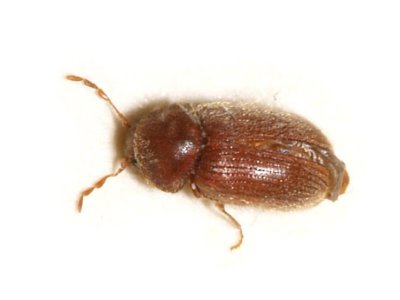

Non-consumable items that are potential food sources for stored product pests include dried flower arrangements (such as pot pourri), rodent baits, bird seed, dry pet food, animal products made into treats (e.g., rawhides), dog bones and related treats, dried fish and fishmeal, cigars and other tobacco products, decorative wall and table arrangements containing plant or animal material, dried fruit peels, jewelry or holiday decorations containing nuts or seeds (especially corn kernels), bean bags, door stops filled with beans, corn, or rice, and stashes of food (mainly seeds) stockpiled by birds and rodents in wall voids, attics, crawlspaces, and chimneys. A partial list of edible food items susceptible to infestation include breakfast foods (especially hot and cold cereals), flour, cake mix, cookies, cornmeal, grits, dry soups, dried herbs and spices, candy, chocolate, rice, dried fruits and vegetables, popped and un-popped popcorn, peas, beans, corn kernels, nuts and seeds (of all kinds of plants), crackers, shelled and unshelled peanuts, powdered milk and protein (e.g., meat and chicken flavorings), biscuit mix, and pasta. Stored product pests vary widely in their food preferences. Insect species in which the adults also feed can be long-lived and survive and continue to infest and feed on susceptible foods for several months to a year. In these cases, the sole purpose of the adult insect is to mate, discover a food resource, and deposit their eggs-all within the few days or weeks they remain alive. In some species of stored product pests, only the larval stages consume food. For most species of stored product pests, there are multiple generations per year. Under optimum conditions (warm temperatures and high humidity), most stored product pests can complete a life cycle in just four to five weeks. The last larval instar pupates and then an adult emerges a short time later. Larval development requires weeks to a month or more to complete. Each successive instar is larger in size and consumes greater amounts of food than the previous instar.
BISCUIT BEETLE LIFETIME SERIES
Following egg hatch, larvae develop through a series of instars while infesting and consuming their food resource (discussed below), where they remain mostly unseen. After deposition, eggs incubate for days to weeks. During their lifetime, females lay approximately 100 to 1,000 eggs, depending upon the species.

Adults often mate soon after emergence from the pupa and immediately begin their search to find food. The life cycle of stored product beetle and moth pests includes an egg stage, several larval stages, a pupal stage, and finally an adult stage. This publication discusses the identification and control of several of the most common species of stored product pests found in southern homes. If food is not limited, populations of stored product pests can multiply rapidly and become widespread and sustained. For homeowners, often the first sign of a stored product pest infestation is the sudden, unexplained and then persistent presence of numerous insects in a particular area of the home. Collectively, this group of insects is referred to as stored product pests. Several dozen insect species infest food and non-food products of plant and animal origin commonly found in homes. Preventing Future Infestations of Stored Product Pests.Solving a Current Infestation of Stored Product Pests.

Cowpea weevils on various beans commonly found in the home.ĭaniel R.


 0 kommentar(er)
0 kommentar(er)
